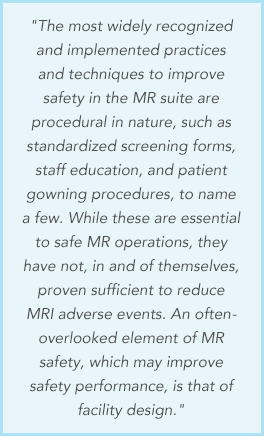| A Message from the SMRT Home Study Educational Seminars Sub-Committee | |||||||
 |
Anne Marie Sawyer, B.S., R.T.(R)(MR), FSMRT Chair, Home Study Educational Seminars Sub-Committee |
 |
Chris Kokkinos, B.App.Sc, PgCert, MRI Chair, SMRT Online Learning Committee |
||||
|
MRI Safety: Incident Reporting, Suite Design & Safety Course We are pleased to present the SMRT Educational Seminars, Volume 19, Number 5: “MRI Safety: Incident Reporting, Suite Design & Safety Course.” This is the 75th accredited home study developed by the SMRT, exclusively for SMRT members. The accreditation is conducted by the SMRT acting as a RCEEM (Recognized Continuing Education Evaluation Mechanism) for the ARRT. Category A credits are assigned to each home study, which can be used to maintain one’s ARRT advanced registry. SMRT Home Studies are also approved for AIR (Australian Institute of Radiography), NZIMRT (New Zealand Institute of Radiation Technology) and CPD Now (The College of Radiographers, United Kingdom) continuing professional development (CPD) activities.
The second article focuses on the planning and design of MR suites. “The most widely recognized and implemented practices and techniques to improve safety in the MR suite are procedural in nature, such as standardized screening forms, staff education, and patient gowning procedures, to name a few. While these are essential to safe MR operations, they have not, in and of themselves, proven sufficient to reduce MRI adverse events. An often-overlooked element of MR safety, which may improve safety performance, is that of facility design.” Unfortunately, many MR suites were designed in the early days of MR before it became apparent that layout and flow for MR was much different than other imaging modalities. Surely that may create challenges for those facilities but does not alleviate the importance of renovation to ensure safety. Moreover, there is simply no excuse for facilities under current design not to seek out expert opinion from those knowledgeable in MR safety. The third and final article describes the creation and implementation of a MR safety course for medical students. “An MRI safety course for medical students should be different from other MRI safety courses. Medical students do not necessarily have the same technical background as specialists in the field of medical imaging. Nevertheless, medical students will become the MRI-referring physicians of the future and would benefit from having a comprehensive MRI safety training included in their medical school curriculum.” This is a fantastic idea. Anecdotal stories are widespread regarding incorrect, inappropriate orders for MR examinations by referring physicians who lack even the most basic MR knowledge. The correct answer is to be proactive, catch them early and provide the necessary training that will result in more efficient ordering of MR studies when they become staff primary care physicians and surgeons. A special thank you to Vera Kimbrell, B.S.,R.T. (R)(MR), FSMRT from Boston, Massachusetts, USA for acting as the Expert Reviewer. Thanks also to Heidi Berns, M.S., R.T.(R)(MR), FSMRT, Chair of the SMRT RCEEM Ad-hoc committee from Coralville, Iowa, USA and all those who participate on this committee by reviewing the home studies for accreditation. Finally, many thanks to Kerry Crockett, Associate Executive Director, Mary Keydash, Director of Marketing, Sally Moran, Director of IT and Web, Barbara Elliott, SMRT Coordinator, and the entire staff in the Concord, California, USA office of the ISMRM and SMRT for their insight and long hours spent supporting these educational symposia.
To access the new Educational
Seminar, |
|||||||
| Click to go back | |||||||
|
Signals is a publication produced four times per calendar year by the
International Society for Magnetic Resonance in Medicine for the benefit of the SMRT membership and those individuals and organizations that support the educational programs and professional advancement of the SMRT and its members. The newsletter is the compilation of editor, Julie Strandt-Peay, BSM, RT (R)(MR) FSMRT, the leadership of the SMRT and the staff in the ISMRM Central Office with contributions from members and invited participants.
|
|||||||

 Three peer-reviewed, published articles appear in this home study
issue. The authors of the fi article review the rates of safety
incident reporting in MRI at their academic medical center. “It is
estimated that adverse events occur in ~10% of hospital admissions,
with about 40-50% of these adverse events considered to be
preventable.” Often in MRI discussions of adverse events, we tend to
focus on magnet related incidents but this article chooses instead
to be more large-scale including all happenings that negatively
affect the patient.
Three peer-reviewed, published articles appear in this home study
issue. The authors of the fi article review the rates of safety
incident reporting in MRI at their academic medical center. “It is
estimated that adverse events occur in ~10% of hospital admissions,
with about 40-50% of these adverse events considered to be
preventable.” Often in MRI discussions of adverse events, we tend to
focus on magnet related incidents but this article chooses instead
to be more large-scale including all happenings that negatively
affect the patient.